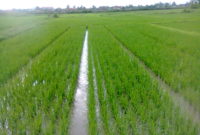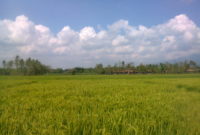The System of Rice Intensification (SRI) is not a standardised, fixed technological method. It is rather a set of ideas, a methodology for comprehensively managing and conserving resources by changing the way that land, seeds, water, nutrients, and human labour are used to increase productivity from a small but well-tended number of seeds.
The System of Rice Intensification involves cultivating rice with as much organic manure as possible, starting with young seedlings planted singly at wider spacing in a square pattern; and with intermittent irrigation that keeps the soil moist but not inundated, and frequent inter cultivation with weeder that actively aerates the soil.

Everybody believes that rice is an aquatic plant and grows best in standing water. Rice is not an aquatic plant; it can survive in water but does not thrive under reduced oxygen (hypoxic) levels. Rice plants spend lot of its energy to develop air pockets (aerenchyma tissue) in its roots under continuous inundation. Nearly 70% of rice root tips get degenerated by flowering period.
SRI: Debunking myths
Under SRI paddy fields are not flooded but kept moist during vegetative phase. Later only one inch water is maintained. SRI requires only about half as much water as normally applied in irrigated rice.Over 1,00,000 farmers are experimenting with this system worldwide at present.
SRI Paddy Cultivation requires less water, involves less expenditure and gives more yields. Thus it is beneficial for small and marginal farmers.SRI was first developed in Madagascar during 1980’s. Its potential is under testing in China, Indonesia, Cambodia, Thailand, Bangladesh, Sri Lanka and India. In Andhra Pradesh. SRI was experimented in all the 22 districts during 2003 Kharif with encouraging results.
SRI Technology Uses Less External Inputs
In SRI paddy cultivation, less quantity of seeds – 2 kg / acre is required. Hence fewer plants per unit area (25 x 25 cm) whereas in mainstream chemical intensive paddy cultivation requires 20 kg seed per acre. (1 acre= apprx 0.4 ha).

A comparison of SRI and conventional method of rice cultivation is as follows
| Particulars | Conventional Method | SRI |
| Spacing | 15×10 cm | 25×25 cm |
| No of plants per sq.m | 66 | 16 |
| No. of seedlings per hill | 3 | 1 |
| No. of plants per acre | 792000 | 64000 |
| Seed requirement per acre | 20 kg | 2 kg |
SRI is initially labour intensive
- Needs 50% more man-days for transplanting and weeding.
- Mobilises labour to work for profit.
- It offers an alternative to the resource poor, who put in their family labour.
- Once the right skills are learnt and implemented, the labour costs will be lesser.
SRI encourages rice plant to grow healthy with
- Large root volume
- Profuse and strong tillers – Maximum tillering (30 tillers/plant can be easily achieved; 50 tillers per plant are quite attainable) occurs concurrently with panicle initiation. Under excellent management even 100 fertile tillers per plant or even more can be achieved due to early transplanting and absence of die back of roots.
- Non lodging
- Big panicles
- More and well filled grain panicles and higher grain weight
- Resists insects because it allows rice to absorb soil nutrients naturally
Source: WASSAN-CSA-WWF Manual on SRI
Do-s and Don’t-s in SRI
- Early Transplanting: Transplant 8-12 day old seedlings, with only two small leaves,( More tillering potential and root growth potential)
- Careful Transplanting: Minimise trauma in transplanting. Remove plant from nursery with the seed, soil and roots carefully and place it in the field without plunging too deep into soil (More tillering potential)
- Wide Spacing: plant single seedlings, not in clumps, and in a square pattern 25cm x 25cm apart or wider. Do not plant in rows. (More root growth potential)
- Weeding and Aeration: use simple mechanical “rotating hoe” that churns up soil; 2 weedings required, (More root growth, due to reduced weed competition, and aeration of soil, giving roots more Oxygen and Nitrogen due to increased microbial activity) Each additional weeding after two rounds results in increased productivity up to 2 t/ha / weeding.
- Water Management: regular water application to keep soil moist but not saturated, with intermittent dryings, alternating aerobic and anaerobic soil conditions (More root growth because it avoids root degeneration, enables better abosrption of nutrients from the soil).
- Compost / FYM: applied instead of or in addition to chemical fertilizer; 10 tons/ha (More plant growth because of better soil health and structure, and more balanced nutrient supply)
- Seed rate 2 kg/acre
- Nursery area 1 cent / acre
- Select healthy seeds
- Pre-sprouted seeds are sown on raised nursery bed
- Prepare nursery bed like the one prepared for garden crops
- Apply a layer of fine manure
- Spread sprouted seed sparsely
- Cover with another layer of manure
- Mulch with paddy straw
- Water carefully
- Banana leaf sheath may be used for easy lifting and transport of seedlings.
- Land preparation is not different from regular irrigated rice cultivation.
- Levelling should be done carefully so that water can be applied very evenly.
- Provide a canal at every 3m distance to facilitate drainage.
- Draw lines both ways at 25x25cm apart with the help of a marker and transplant at the intersection.
- 8-12 days old seedlings are transplanted
- Care should be taken during pulling out and transplanting of seedlings
- A metal sheet is inserted 4-5 inches below the seed bed and the seedlings along with soil lifted without any disturbance to the root.
- Seedlings are transplanted shallow and therefore establish quickly. Single seedling with seed and soil are transplanted by using index finger and thumb and gently placing them at the intersection of markings.
- Initially requires 10-15 persons to transplant one acre.
- The purpose of irrigation is just to wet the soil, just enough to saturate the soil with moisture
- Subsequent irrigation is only when soil develops fine cracks.
- Regular wetting and drying of soil results in increased microbial activity in the soil and easy availability of nutrients to the plants.
- Absence of standing water leads to more weed growth in SRI.
- Incorporate the weeds in the soil by moving the weeder between the rows
- Weeds close to the hills/tillers have to be removed by hand
- Higher yields – Both grain and straw
- Reduced duration (by 10 days)
- Lesser chemical inputs
- Less water requirement
- Less chaffy grain %
- Grain weight increased without change in grain size
- Higher head rice recovery
- Withstand cyclonic gales
- Cold tolerance
- Soil health improves through biological activity
- Higher labour costs in the initial years
- Difficulties in acquiring the necessary skills
- Not suitable when no irrigation source available
